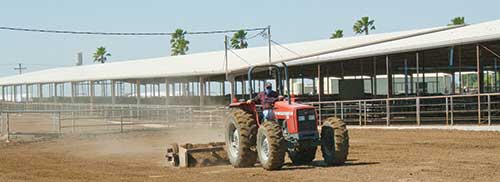
Following the tragic death of a dairy farm employee in northwest Wisconsin, OSHA has begun inspecting more dairy farms to identify risks and ensure worker safety. Since most dairy farms have not worked with OSHA, Hoard's Dairyman posed a series of questions to the federal agency about field audits, and, more importantly, how dairy producers can improve safety on their operations. What follows are responses from Scott Allen, director of public affairs with OSHA.
What type of OSHA field inspections exist?
OSHA conducts both unprogrammed and programmed inspections. Unprogrammed inspections are conducted in response to reports of imminent dangers in the workplace, fatalities/catastrophes, complaints, and referrals.
Programmed inspections are workplace inspections based on objective or neutral selection criteria. Programmed inspections are initiated under national, local, and special emphasis programs. The inspections will be programmed inspections.
When a farm or business is selected for field inspections, what areas are OSHA officials looking to inspect? What are specific safety issues or areas of focus on dairy operations?
When conducting an inspection, the focus of the inspection is limited to the scope of the nature of the inspection. That differs based on whether the inspection was a result of unprogrammed or programmed activity. Common hazardous dairy farm activities include:
- Operating farm vehicles on manure push-off platforms without vehicle guarding mechanisms
- Working around unfenced earthen manure storage facilities
- Working near damaged or improperly installed electrical systems
- Operating skid steers or tractors without sufficient training
- Working near unguarded PTO (power take-off) shafts on tractors and other equipment
- Working near unguarded belts, pulleys, chains, and sprockets
- Entry into corn and grain storage bins and silos
- Entry into manure storage vessels and below grade collection systems
- Entry into milk vessels such as bulk tanks or semi tankers used to haul milk
- Maintaining and servicing farm vehicles without steps and devices to control sources of hazardous energy
- Operating farm vehicles without rollover protective devices (ROPS)
- Working on or around horizontal bunker silos
- Working with hazardous chemicals without training and/or personal protective equipment
Typically, any establishment, regardless of size, is eligible for an OSHA inspection if an employer-employee relationship exists. However, OSHA directive CPL 02-00-51, Enforcement Exemptions and Limitations under the Appropriations Act, sets guidance with respect for enforcement activity for establishments covered under the Appropriations Act which include farming operations, temporary labor camp operations, and establishments in certain standard industrial classification (SIC) codes (low-lost workday case rate establishments) with 10 employees or less.
The Appropriations Act exempts farming operations from enforcement of all rules, regulations, standards, or orders under the Occupational Safety and Health Act if the farming operation employs 10 or fewer employees currently and at all times during the last 12 months and has not had an active temporary labor camp during the preceding 12 months. Immediate family members of farm employers are not counted when determining the number of employees.
Farming operations with more than 10 employees and those with 10 or fewer employees with temporary labor camp activity are not exempt from OSHA inspection under the Appropriations Act.
How long does a typical inspection last?
Duration of an OSHA inspection depends on many factors, including scope and nature of the inspection, the operation's size, availability of managers, availability of employees, employer cooperation, and workplace condition. Typically, fatality and catastrophe inspections are the most time-intensive and require substantial resources to conduct a thorough accident investigation.
How does a farm business go about establishing a good safety program?
Benchmark with other members of your industry. Work with state agricultural outreach programs and personnel. Actively seek and attend training provided by business associations and tech schools. In addition, OHSA consultation services are available in each state to small business employers.
What would OSHA suggest as far as documenting safety training? Who should participate? How often should safety training take place?
Nature, frequency, and documentation of training depends on each specific hazard identified. For Agriculture, 29 CFR 1928 contains rules and regulations for the agricultural sector, including topics such as but not limited to rollover protective structures (ROPS) for tractors, protective frames and enclosures for tractors, tractor operator training, guarding of farm field and farmstead equipment, field sanitation, temporary labor camps, storage and handling of anhydrous ammonia, slow- moving vehicles, chemical hazard communication, cadmium, and retention of DOT markings, placards, and labels. These rules and regulations need to be followed and any specific requirements related to employee training be conducted and documented as dictated.
In addition, Section 5(a)(1) of the Occupational Safety and Health Act of 1970 specifies that each employer shall furnish a place of employment free from recognized hazards that are causing and are likely to cause death or serious physical harm to employees. The employer should follow established and recognized guidelines within their industry to ensure the safety and health of their employees.
At what point does OSHA become concerned with employee housing?
A temporary labor camp means farm housing directly related to the seasonal or temporary employment of farm workers. Housing includes both permanent and temporary structures located on or off the property. When OSHA determines that a temporary labor camp is or may be in existence, then that is taken into consideration when applying the enforcement policies stipulated by the Appropriations Act as stated above.
If employee housing is inspected during a field audit, what types of things are you looking for?
The Wage and Hour Division of the Department of Labor normally will exercise responsibility for enforcement in agriculture of OSHA field sanitation and temporary labor camp standards. Please refer to 29 CFR 1928.110 and 1928.142 for more details.





